
Oklahomans and Space
Oklahoma Astronauts

Leroy Gordon Cooper Jr. (photo courtesy of National Aeronautics and Space Administration).
Leroy Gordon Cooper Jr.
Date of Birth: March 6, 1927
Oklahoma Connection: Born in Shawnee, Oklahoma
Missions: Mercury–Atlas 9 and Gemini 5
Leroy Cooper’s nickname was Gordo. His grandmother settled in Oklahoma in the 1880s and lived long enough to see him go to space. His father encouraged his love of flying, and by age eight, Cooper could fly his family’s small airplane. By age twelve, he made his first solo flight. He joined the Marines in World War II and transferred to the Air Force in 1949, where he studied aeronautics and engineering. NASA selected him to be an astronaut in 1959 after a long series of physical and mental testing. He became one of the members of the Project Mercury astronauts, or the “Mercury Seven.”
In 1963, Cooper flew the last and longest flight of the Mercury series on the spacecraft Faith 7, which lasted for 34 hours and 22 minutes. During re-entry to earth on Faith 7, the automatic controls failed and he had to manually take over flying. He landed successfully. Cooper helped prove that humans could survive in space long enough for a round trip to the moon when he and pilot Charles Conrad spent eight days in space on the Gemini 5 in 1965. He later would work as fellow Oklahoman astronaut Tom Stafford’s backup commander on the Apollo 10 mission in 1969. In total, he spent 222 hours in space. Leroy Cooper Jr. died on October 4, 2004.

The Mercury 7 astronauts gathered in flight gear. Cooper is second from the left (photo courtesy of National Aeronautics and Space Administration).

Mercury astronauts (photo courtesy of National Aeronautics and Space Administration).

The original Mercury astronauts; Cooper is sitting to the far right (photo courtesy of National Aeronautics and Space Administration).

Leroy Gordon Cooper Jr. “Welcome Back to Earth” button (2003.095.004, Bill Moore Collection, OHS).

Oklahoma Senator Kerr with Leroy Gordon Cooper Jr. (middle) (22668.2, Carter Bradley Collection, OHS).
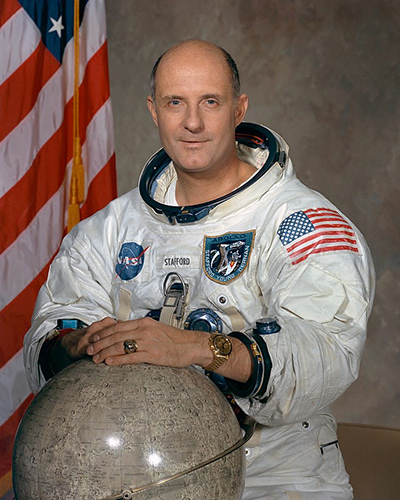
Tom Stafford (photo courtesy of National Aeronautics and Space Administration).
Thomas Patten Stafford
Date of Birth: September 17, 1930
Oklahoma Connection: Born in Weatherford, Oklahoma
Missions:
Gemini 6
Gemini 9
Apollo 10
Apollo-Soyuz
Stafford joined the US Naval Academy, and afterwards joined the US Air Force. His first flight was on the Gemini 6. He and his co-pilot Walter Schirra proved that it was possible for two spacecraft to fly near one another in order to dock, or connect with, another spacecraft. The Gemini 6 and their replacement, Gemini 7, had a successful rendezvous on December 15, 1965, coming within one foot of each other in space. Stafford’s next mission came unexpectedly when the crew of Gemini 9 died tragically in a plane crash. Stafford was part of the backup crew that stepped up to continue the mission. While on the Gemini 9, his partner Eugene Cernan was doing a spacewalk when his face shield fogged over, and his communications system failed. Stafford was able to talk him back inside, saving Cernan’s life. Later, astronauts would bring an anti-fog solution to treat their visors before spacewalks as a result of this occurrence.
Stafford commanded the Apollo 10 mission in 1969, where he flew in the largest rocket ever built, the Saturn V. While in space, the rocket separated into a lunar module and a command module. Stafford and the lunar module would fly within 10 miles of the moon’s surface. This flight helped prepare for the next mission to walk on the moon by mapping out the path that Apollo 11 would later take. For his last mission on Apollo-Soyuz, Stafford performed the first international rendezvous and docking, where three American astronauts met and worked together with two Russian cosmonauts. When they met, Stafford and Russian Alexei Leonov shook hands, known as the “Handshake in Space,” which helped introduce the end of the Cold War and allowed the Russians and Americans to begin collaborating in space. Altogether, Stafford spent 507 hours and forty-three minutes in space. Thomas Stafford passed away on March 18, 2024.
Stafford Air & Space Museum
The Stafford Air & Space Museum is located in Weatherford, Oklahoma, Thomas P. Stafford’s hometown. The museum houses one of the finest collections of aviation and space flight exhibits in the central United States and features a large series of aeronautical and space artifacts. The museum features an exhibit area for the Gemini, Apollo, and space shuttle programs as well as artifacts from each mission. You can learn more about the museum at www.staffordmuseum.com.

Stafford touching Snoopy, the mission's mascot, for good luck (photo courtesy of National Aeronautics and Space Administration).

Thomas Stafford speaking at the Oklahoma Historical Society (19687.HS.OHS.EV.1.21, Chester R. Cowen Collection, OHS).

Astronauts during training, including Thomas Stafford (standing, left) (photo courtesy of National Aeronautics and Space Administration).

Stafford and Cosmonaut Leonov, 1975 (18220.l11.0, Jerry Elliott Collection, OHS).

Autographed picture of Gemini spacecraft by Thomas Stafford (22668.4, Carter Bradley Collection, OHS).

Gemini 6-A, previously on display in the Oklahomans and Space exhibit at the Oklahoma History Center.
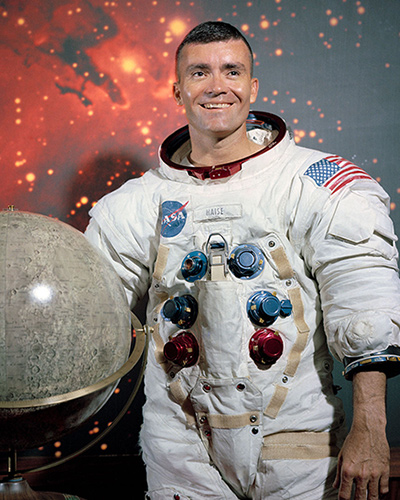
Fred Haise (image courtesy of National Aeronautics and Space Administration).
Fred Wallace Haise
Date of Birth: November 14, 1933
Oklahoma Connection: Joined the Oklahoma Air National Guard and attended the University of Oklahoma
Missions: Apollo 13
Haise began his military career in 1952 as a Naval and Marine Corps pilot and afterwards joined the Oklahoma Air National Guard in 1957. He graduated from the University of Oklahoma in 1959, and would then work for the US Air Force and NASA. NASA selected him as an astronaut in 1966. He was the backup lunar module pilot for both Apollo 8 and Apollo 11, and was finally chosen as the main lunar module pilot for the Apollo 13 mission, along with Jim Lovell, the mission commander, and Jack Swigert, the command module pilot.
The mission was supposed to last ten days and they were to land on the moon, making Haise the sixth person to walk on the moon. However, just a few days into the mission, there was an explosion in the command module, and the astronauts noticed gas leaking into space. The service module oxygen tank had failed. This was very dangerous because the astronauts were 200,000 miles from Earth and were not sure if they would have enough power to make it home. The astronauts got out of the command module and closed it off, planning to use the lunar module as a “lifeboat.” They had to conserve electricity, food, and water to survive the rest of the way home. There were also problems with the navigation systems, but Haise was able to communicate with Mission Control to fly everyone back, and they landed on Earth safely. Despite this terrifying experience, Haise was disappointed that he did not make it to the moon.
In total, Haise spent 142 hours and fifty-four minutes in space. While he would not go to space again, he would later work on the Space Shuttle Program for NASA to help test how the shuttles would fly and land. In 1995, there was a movie made about the Apollo 13 flight, in which Haise is portrayed by actor Bill Paxton.

Apollo 13 crew; Fred Haise is on far right (photo courtesy of National Aeronautics and Space Administration).

The flight director watches Apollo 13 astronaut and lunar module pilot Fred Haise onscreen in the Mission Operations Control Room. Shortly after, an explosion occurred that risked the lives of the crew (photo courtesy of National Aeronautics and Space Administration).
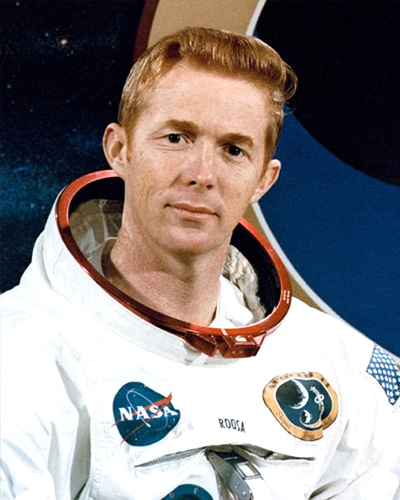
Stuart Allen Roosa (photo courtesy of National Aeronautics and Space Administration).
Stuart Allen Roosa
Date of Birth: August 16, 1933
Oklahoma Connection: As a boy, he and his family moved from Colorado to Claremore, Oklahoma, where he attended high school. He also attended Oklahoma A&M College (now Oklahoma State University).
Missions: Apollo 14
“Stu” Roosa always wanted to be a pilot when he grew up. As a teenager, he worked for the US Forest Service fighting fires. He later joined the US Air Force and would get his degree in aeronautical engineering. Roosa became an astronaut in 1966, where he served as a support crew member for Apollo 9. He then served as the command module pilot on Apollo 14 with Alan Shepard as commander and Edgar Mitchell as the lunar module pilot, which went to the moon in 1971. Roosa flew in lunar orbit by himself for thirty-three hours while Shepard and Mitchell walked on the moon.
As part of the Apollo 14 mission, Roosa brought tree seeds into space for a project by the US Forest Service and NASA. The seeds were later planted back on Earth and were known as “Moon Trees.” Roosa would later serve as the backup command module pilot for Apollo 16 and Apollo 17, but would not return to space. He later worked on the Space Shuttle Program. In total, he spent 217 hours in space. Stuart Roosa died on December 12, 1994.

The Apollo 14 command module with astronaut Stuart A. Roosa landing in the Pacific Ocean (photo courtesy of National Aeronautics and Space Administration).
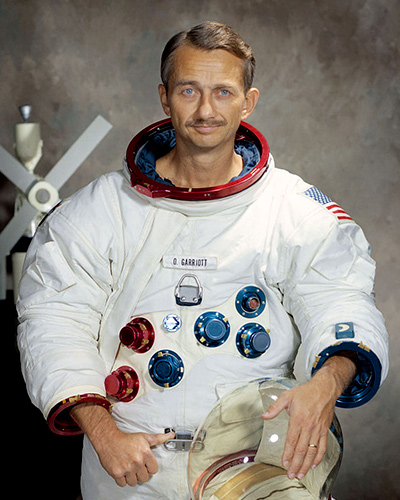
Owen Garriott (photo courtesy of National Aeronautics and Space Administration).
Owen Kay Garriott
Date of Birth: November 22, 1930
Oklahoma Connection: Born in Enid, Oklahoma
Missions:
Skylab 3
STS-9/Spacelab 1
In high school, Garriott worked at a radio station as an engineer and earned his amateur radio license. He attended the University of Oklahoma, where he studied electrical engineering and joined the US Navy ROTC. Garriott would then serve as an electronics officer in the Navy until 1956. He earned his Ph.D. from Stanford University in 1960 in electrical engineering and would teach the subject there as well.
In 1965, NASA chose Garriott as one of the first scientist-astronauts. He flew on the Saturn I-B rocket in 1973 for the Skylab-3 mission, where he conducted many experiments, including solar observations and medical experiments. He was a mission specialist alongside five other crew members, the largest group yet to fly into space, on the STS-9 Columbia in 1983 for the new laboratory called Spacelab. Over seventy different experiments and tests were conducted in just ten days. Also on this mission, Garriott conducted the first human amateur radio operation in space using his own radio call letters, W5LFL. You can listen to some examples of his transmissions at aa5tb.com/satellite.html. Altogether, he spent 1,674 hours and fifty-six minutes in space.
Garriott would also serve as director of Science and Applications, assistant director of Space Science, and program specialist for the Space Shuttle Program for NASA until his retirement in 1986. In 2008, his son Richard became the first American son of an astronaut to fly in space when he visited the International Space Station. Owen Garriott died on April 15, 2019.

Owen Garriott, back (22311.S.72.17482, Jerry Elliott Collection, OHS).
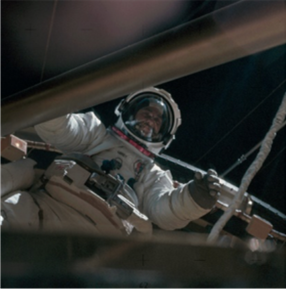
Garriott on an EVA to deploy a sunshade on Skylab (photo courtesy of the National Aeronautics and Space Administration).
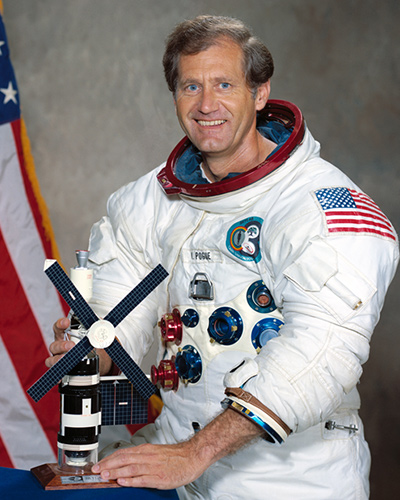
William Pogue (photo courtesy of National Aeronautics and Space Administration).
William Reid Pogue
Date of Birth: January 23, 1930
Oklahoma Connection: Born in Okemah, Oklahoma
Missions: Skylab 4
Bill Pogue was born in Okemah, Oklahoma and grew up in Sand Springs, Oklahoma. He studied education at Oklahoma Baptist University and got his Masters of Science degree from Oklahoma A&M (now Oklahoma State University) in mathematics. In 1951, he joined the US Air Force and fought in the Korean War. From 1955 to 1957, Pogue was a member of the elite US Air Force Thunderbirds, and would also teach at the Air Force Academy. In 1966, he was chosen to be an astronaut. After working as support crew for several Apollo missions, Pogue became a pilot for the third mission to Skylab 4 and went to space on the Saturn I-B rocket in 1973. This was the last and longest of the Skylab missions, and the astronauts performed many medical experiments and exercise tests, and extensive observations of the sun through Skylab’s Apollo Telescope Mount.
Altogether, Pogue spent 2,017 hours in space. He would later work in several other aerospace-related fields, including working as a consultant for the International Space Station. William Pogue died on March 3, 2014.

Pogue is balanced on one finger in zero-gravity by another astronaut (photo courtesy of National Aeronautics and Space Administration).

Presentation flag carried on Skylab 2 by William Pogue to commemorate all the American Indian tribes in Oklahoma (1974.007, Col. William R. Pogue Collection, OHS).
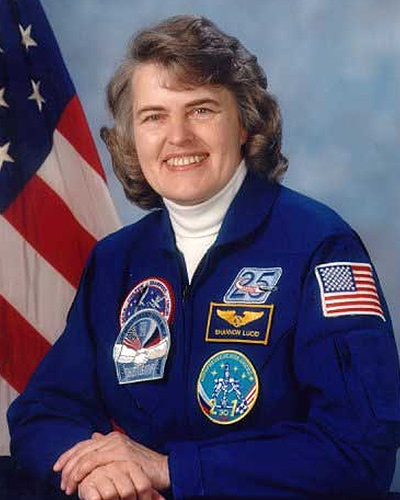
Shannon Lucid (photo courtesy of National Aeronautics and Space Administration).
Shannon Wells Lucid
Date of Birth: January 14, 1943
Oklahoma Connection: Raised in Bethany, Oklahoma
Missions:
Discovery STS-51G
Atlantis STS-34
Atlantis STS-43
Columbia STS-58
Atlantis STS-76
Shannon Lucid’s parents were missionaries in China when Lucid was born in Shanghai. Her parents came back to the United States, and Lucid grew up in Bethany, Oklahoma. She attended the University of Oklahoma and received her B.S., M.S., and Ph.D. in biochemistry. While in college, Lucid took flying lessons and later worked as a research associate for the Oklahoma Medical Research Foundation.
In 1978, NASA selected her as one of the first American female astronauts. She would fly on five missions and conduct many biomedical experiments and satellite launches. Her fifth and final mission was as a board engineer on the Russian Space Station, Mir. On this mission, her return was delayed by six weeks, making her Mir stay a total of 188 days and four hours. She set the record for the most hours in orbit by a non-Russian, and the record for the most hours in orbit by a woman.
In 2002, Lucid would move to work in NASA management, serving as their chief scientist, as well as a lead capsule commander at Mission Control for many Space Shuttle missions. Her lifetime of work at NASA and record-setting achievements made her a role model for many young girls around the world.

Shannon Lucid’s polo shirt (1999.057.001, Shannon Lucid Collection, OHS).

First female astronaut candidates, 1978; Lucid on far left (photo courtesy of National Aeronautics and Space Administration).
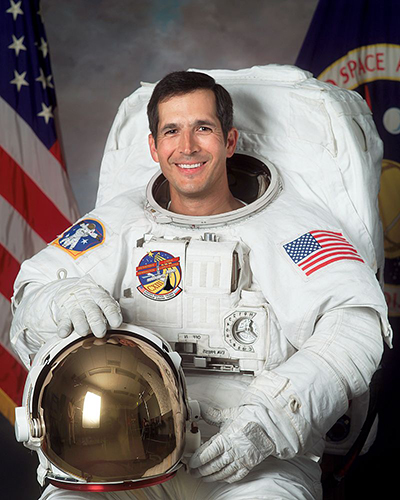
John Herrington (photo courtesy of National Aeronautics and Space Administration).
John Bennett Herrington
Date of Birth: September 14, 1958
Oklahoma Connection: Born in Wetumka, Oklahoma
Missions: STS-113
John Herrington is a Chickasaw Indian. He earned a degree in mathematics from the University of Colorado and later joined the Navy and learned to fly airplanes. He then earned his master’s degree in aeronautical engineering from the US Navy Postgraduate School. Herrington flew in the shuttle Endeavor to the International Space Station as a mission specialist, where he installed new parts on the space station. Herrington was the first member of an American Indian tribe to go to space. He took items with him into space that were significant to American Indian history and culture, including an arrowhead, three eagle feathers, and a Chickasaw Nation flag. Herrington spent 330 hours and forty-seven minutes in space, including almost twenty hours of extravehicular activity (EVA) outside the space station. His spacewalks were commemorated on the 2019 design for the Native American $1 coin, which features Sacagawea on the reverse side.

Excerpt from The Daily Oklahoman article “First Indian in space began journey in state,” from Tuesday, September 10, 2002.
Oral Histories
You can read the transcripts of oral history interviews with these Oklahoman astronauts at this website:
historycollection.jsc.nasa.gov/JSCHistoryPortal/history/oral_histories/participants_full.htm
Leroy “Gordo” Cooper
Thomas P. Stafford
Fred W. Haise
Owen K. Garriott
William R. Pogue
Shannon W. Lucid
Oklahoman Space Exploration Contributors
Astronauts could not travel to space without the hard work of scientists, engineers, mathematicians, physicists, computer scientists, pilots, and others. While there are many astronauts from Oklahoma, lots of other Oklahomans have worked for NASA and the air and space industry and contributed to the effort to explore and study space.
For example, Jeffrey Morgan Moore, who attended the University of Oklahoma, is a scientist who studies rocks and soil from Mars and Jupiter. Carol Ann McLemore, from Tulsa, Oklahoma, is a NASA engineer who helped design the International Space Station and is researching technologies for potential settlement of the Moon, Mars, and beyond. Charles R. Thomas, from Ada, Oklahoma, was a computer programmer and worked on the Apollo program. Gary L. Tesch from El Reno, Oklahoma, served as a lawyer for NASA. Velma Clark, from Custer City, Oklahoma, wrote, proofread, and edited early NASA engineering handbooks.

James Webb (photo courtesy of National Aeronautics and Space Administration).
James Edwin Webb
Date of Birth: October 7, 1906
Oklahoma Connection: Moved to Oklahoma in 1953
James Webb was a former Marine and lawyer who was the director of the Bureau of Budget and Under Secretary of State in Harry Truman’s administration. He moved to Oklahoma City in 1953 to work for Kerr-McGee, an energy company. As a community leader, he established the Frontiers of Science Foundation, which helped promote science education in schools. In 1961 he became the administrator of NASA under President John F. Kennedy. He served until 1968, and played a huge role in helping to get the first man on the moon through his work with Washington, DC, lawyers and politicians to help fund NASA and establish bonds with the community.
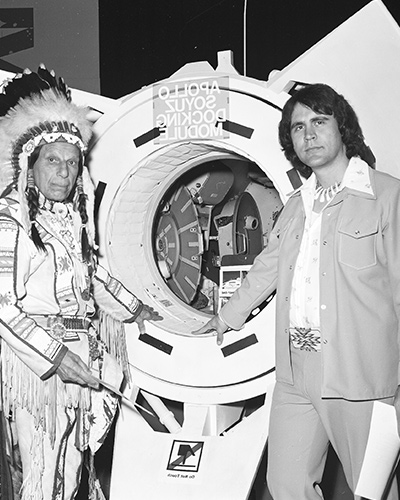
Jerry Elliott (right) with Iron Eyes Cody and the Apollo-Soyuz docking module (22311.80.11.3.7, Jerry Elliott Collection, OHS).
Jerry Chris Elliott
Date of birth: February 6, 1943
Oklahoma Connection: Born in Oklahoma City, Oklahoma
Jerry Elliott is a Cherokee and Osage Indian. As a child, he had a vision that he would help get people to the moon. His grandfather often told him stories about his time as an aircraft engineer for Wiley Post. Elliott attended the University of Oklahoma to study physics, and became a Guidance Engineer for NASA in 1966. He worked on the Gemini, Apollo, and Space Shuttle programs, resulting in a career lasting 40 years. He fulfilled his vision in 1969 when he was working in Mission Control when Apollo 11 landed on the moon.
Elliott received numerous awards and commendations throughout his career, including the Presidential Medal of Freedom for his work returning the Apollo 13 astronauts. He led many design and project engineering efforts for NASA, and also founded the American Indian Science and Engineering Society.

Donna Shirley (photo courtesy of National Aeronautics and Space Administration).
Donna Shirley
Date of birth: July 27, 1941
Oklahoma Connection: Born in Pauls Valley, Oklahoma
Donna Shirley dreamed of going to Mars as a little girl and was interested in aviation from a young age. She enrolled in the University of Oklahoma’s engineering program in 1958, but her college advisor told her that “girls can’t be engineers.” However, she persevered and finally received her B.A. in aerospace engineering in 1965. Shirley worked for the Jet Propulsion Lab in California helping to design landing proposals for a Mars mission, where she was the only female engineer out of nearly 2,000 engineers.
In 1994 she became the Mars Program Manager in the Office of Mars Exploration, and helped land the first rover on Mars in 1997. Her work as the program manager for the program landed her national and international attention. In 1998, Shirley retired from NASA and served as assistant dean at the University of Oklahoma’s College of Engineering, the same place she had once been told that “girls can’t be engineers.”

Wiley Post in the pressurized suit (23115-AL-19-4, Arch Dixon Collection, OHS).
Wiley Hardeman Post
Date of birth: November 22, 1898
Oklahoma Connection: Moved to Oklahoma in 1907
Wiley Post wanted to become a pilot from the age of fourteen, even acting as a parachute jumper for a flying circus. When he eventually purchased his own plane, he flew for oil companies, and was hired to fly full time by an oilman named F. C. Hall. He bought Post his own plane to fly in 1930, named after Hall’s daughter, Winnie Mae. Post is best known for setting a record for flying around the world in the Winnie Mae, doing so in eight days, fifteen hours, and fifty-one minutes.
Post also wanted to fly higher than anyone had before. He could not do so safely in the Winnie Mae, because it was made of wood, and the pressure in the air was too strong to allow the plane to keep him safe at extreme altitudes. He contacted the B. F. Goodrich Company to design him a suit that would allow him to fly higher into the atmosphere. The suit would be made up of multiple layers and included parachute fabric, rubberized lining, and an aluminum diving helmet. In 1934, Wiley Post flew the Winnie Mae to 40,000 feet, and later flew to as high as 50,000 feet.
Wiley Post made it possible for astronauts to survive in space by helping to develop the first pressurized suit. His suit is what set the model to design the suits that astronauts wear. Tragically, Post and comedian Will Rogers died in a plane crash on August 15, 1935. While his flying career was short, Wiley Post set records and introduced designs whose impacts can still be seen today.
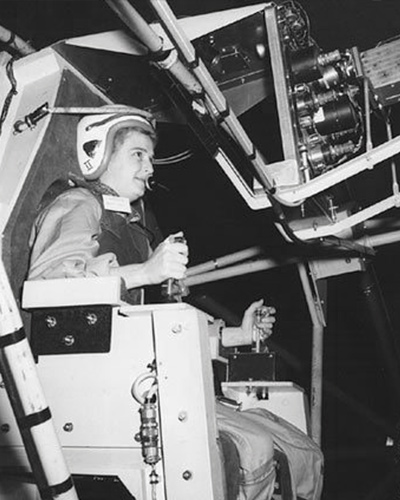
Geraldyn Cobb (photo courtesy of National Aeronautics and Space Administration).
Geraldyn “Jerrie” Cobb
Date of birth: March 5, 1931
Oklahoma Connection: Born in Norman, Oklahoma
Jerrie Cobb learned to fly her father’s plane by age twelve, and became a pilot by age sixteen. By age nineteen, she was a certified flight instructor, and by twenty-one, she was flying fighter planes and bombers to Air Force bases around the world. Cobb went on to set world records in flight speed, distance, and altitude, even becoming the first woman to fly in the Paris Air Show, the world’s largest air exposition.
In 1960, when NASA was performing medical tests to determine who would be the first astronauts on the Mercury flight program, they decided to invite women to take the same tests. Cobb became the first woman astronaut trainee in 1960, and passed all three phases of testing with flying colors. She also became a consultant for the future use of women astronauts alongside famed aviator Jacqueline Cochran, and testified in Washington, DC to lobby for their inclusion. In 1963, NASA decided to officially cancel the female astronaut testing program. Cobb resigned and became a humanitarian aid worker to South America, winning many awards for her work.
While she never made it to space, Cobb is often referred to as one of the first female astronauts. The first woman to go to space, Soviet cosmonaut Valentina Tereshkova, even said that Cobb was one of her role models. Jerrie Cobb passed away on March 18, 2019, and is remembered today for her tenacity and pioneering spirit.
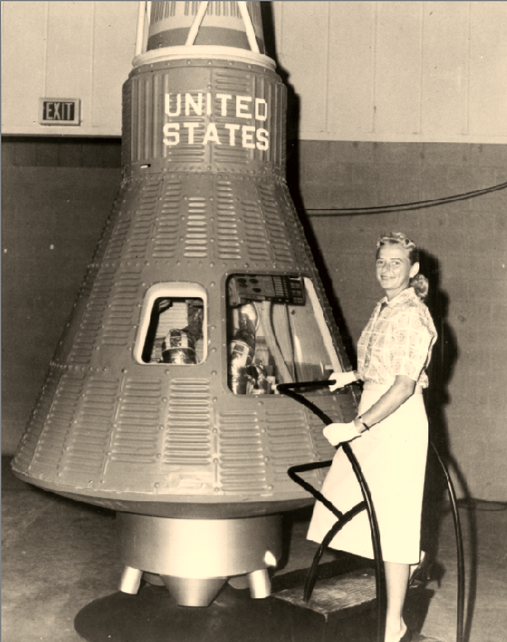
(Photo courtesy of National Aeronautics and Space Administration.)
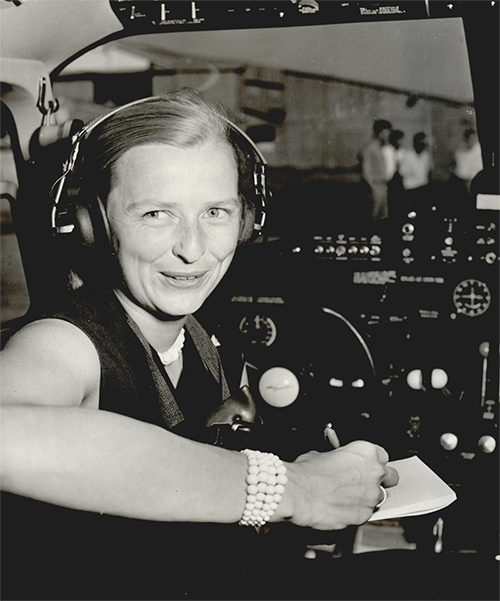
Jerrie Cobb after setting world record, from the Oklahoma Times newspaper (2012.201.B0138.0280, Oklahoma Publishing Company Photography Collection, OHS).

